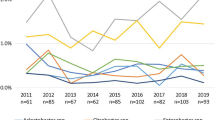Summary
The minimum inhibitory concentrations (MIC) of ciprofloxacin were determined for 441 uropathogens from patients with complicated and/or hospital acquired urinary tract infections (UTI). None of theEnterobacteriaceae was resistant (MIC ≥ 4 mg/l), but 21.7% of enterococci, 28.3% ofPseudomonas spp. and 38.5% of staphylococci were. Subtyping of the strains revealed that with staphylococci there was no clonal spread of resistant strains. In the case of enterococci andPseudomonas spp., however, cross infections played a major role (46% and 40% respectively). In a retrospective analysis of 370 UTI episodes caused byPseudomonas aeruginosa (74), enterococci (185) or staphylococci (111) there was no difference between sensitive and resistant strains with respect to clinical aspects and rates of elimination by appropriate anti-bacterial therapy. The rates of spontaneous disappearance without antibacterial therapy ranged from 28% in the case ofP. aeruginosa up to 63% in the case of coagulase-negative staphylococci. This implies that especially in UTI caused by gram-positive cocci an indication for antibacterial therapy should be weighted thoroughly and fluoroquinolones should only be used in accordance with sensitivity testing.
Zusammenfassung
Die minimalen Hemmkonzentrationen (MHK) von Ciprofloxacin wurden für 441 Isolate von Patienten mit komplizierten und/oder im Krankenhaus erworbenen Harnwegsinfektionen (HWI) bestimmt. VonEnterobacteriaceae war kein Stamm resistent (MHK ≥ 4 mg/l). Bei Enterokokken lag die Resistenzrate bei 21,7%, beiPseudomonas spp. bei 28,3% und bei Staphylokokken bei 38,5%. Die Typisierung der Staphylokokken ergab keine klonale Ausbreitung von resistenten Stämmen. Bei Enterokokken undPseudomonas spp. spielten Kreuzinfektionen jedoch eine wichtige Rolle; sie lagen bei 46% bzw. 40%. Bei einer retrospektiven Auswertung von 370 HWI-Episoden mitPseudomonas aeruginosa (74), Enterokokken (185) und Staphylokokken (111) ergab sich hinsichtlich klinischer Merkmale und der Eliminationsraten bei geeigneter Antibiotikatherapie kein Unterschied zwischen dem Verhalten empfindlicher und resistenter Stämme. Die spontanen Eliminationsraten ohne Antibiotikatherapie reichten von 28% bei.P. aeruginosa bis zu 63% bei Koagulase-negativen Staphylokokken. Dies bedeutet, daß besonders bei HWI mit grampositiven Erregern die Indikation zur antibakteriellen Chemotherapie sorgfältig gestellt werden sollte, wobei Fluorochinolone nur nach Antibiogramm eingesetzt werden sollten.
Similar content being viewed by others
References
Naber, K. G., Wittenberger, R. In-vitro-Aktivität von Gyrase-Hemmern gegenüber Erregern von komplizierten Harnwegsinfektionen. Fortschr. Antimikr. Antineopl. Chemother. 6 (1987) 1801–1809.
Braulke, C., Witte, W., Paul, P. Species-Bestimmung Koagulase-negative Staphylokokken im Mikrotiter-Verfahren. Z. Klin. Med. 45 (1990) 1737–1740.
Witte, W. Typing of multiresistant and methicillin resistantStaphylococcus aureus by classical and molecular methods and their use in epidemiology. In:R. P. Novick, R. Skurray (eds.), Molecular biology of the staphylococci. VCH Verlagsgesellschaft Heidelberg/New York 1990, pp. 602–615.
Witte, W., Grimm, H. Occurrence of quinolone resistance inS. aureus from nosocomial infections. Epidemiol. Infect. 109 (1992) 413–421.
Bauernfeind, A., Petermüller, C., Burrows, J. R. Modified procedure for pyocin typing ofPseudomonas aeruginosa. Zbl. Bakt. Hyg. 340 (1978) 271.
Fyfe, J. A., Harris, G., Govan, J. R. W. Revised pyocin typing method forPseudomonas aeruginosa. J. Clin. Microbiol. 20 (1984) 47.
Grothues, D., Tümmler, B. Genome analysis ofPseudomonas aeruginosa by field inversion gel electrophoresis. FEMS Microbiol. Lett. 48 (1987) 419–422.
Schwartz, D. C., Canter, C. R. Separation of yeast chromosome sized DNAs by pulsed field gradient gel electrophoresis. Cell 37 (1983) 67–75.
Heisig, P., Wiedemann, B. Use of a broad-host-range gyrA plasmid for genetic characterization of fluoroquinolone-resistant gram-negative bacteria. Antimicrob. Agents Chemother. 35 (1991) 2031–2036.
Naber, K. G., Witte, W., Bauernfeind, A., Wiedemann, B., Grimm, H. Resistenzentwicklung gegenüber Fluorochinolonen. Untersuchungen mit Erregern von Patienten mit komplizierten Harnwegsinfektionen. Chemotherapie J. 2 (1993) 106–111.
Sauerwein, D., Bauernfeind, A. Klinische Erfahrungen bei der Behandlung von Harnwegsinfektionen bei Querschnittsgelähmten mit Norfloxacin. Fortschr. Antimikr. Antincopl. Chemother. 3 (1984) 759–964.
Naber, K. G.: Uncomplicated urinary tract infection — is single dose therapy effective? Int. J. Antibiotics (in press).
Author information
Authors and Affiliations
Rights and permissions
About this article
Cite this article
Naber, K.G., Wagenlehner, F., Witte, W. et al. Clinical significance and spread of fluoroquinolone resistant uropathogens in hospitalised urological patients. Infection 22 (Suppl 2), S122–S127 (1994). https://doi.org/10.1007/BF01793576
Issue Date:
DOI: https://doi.org/10.1007/BF01793576




